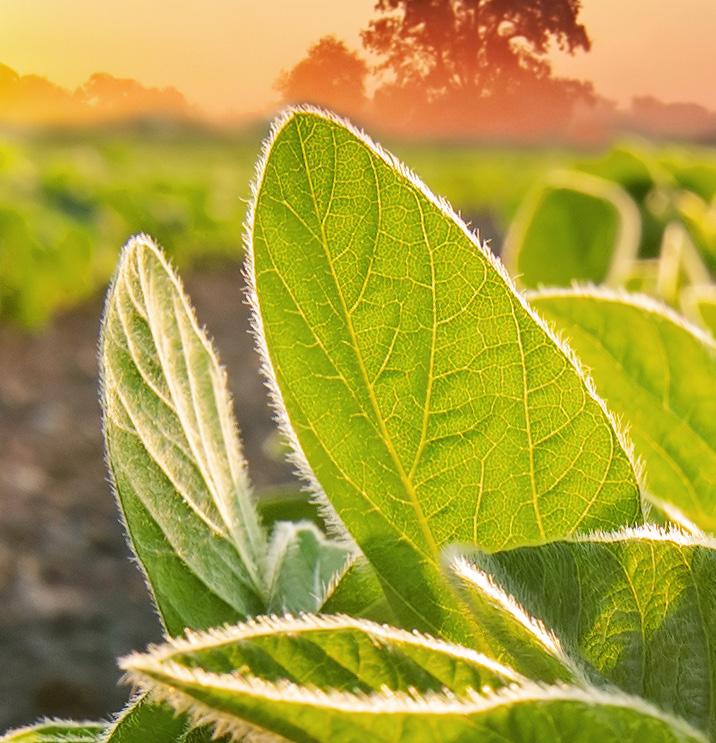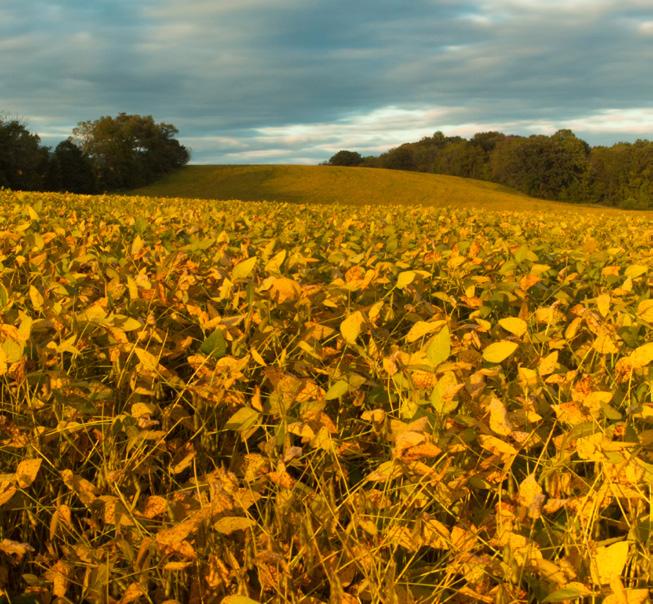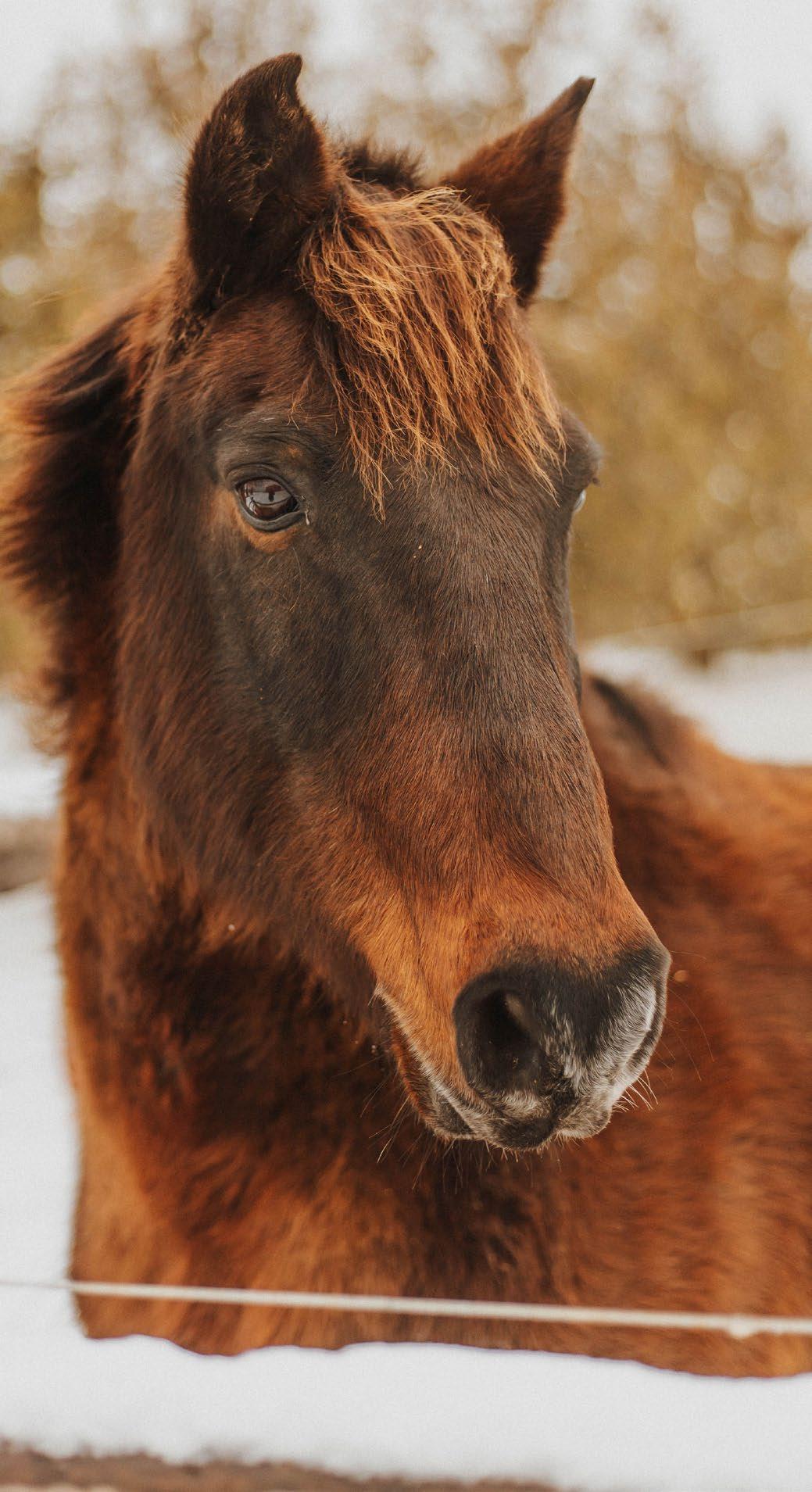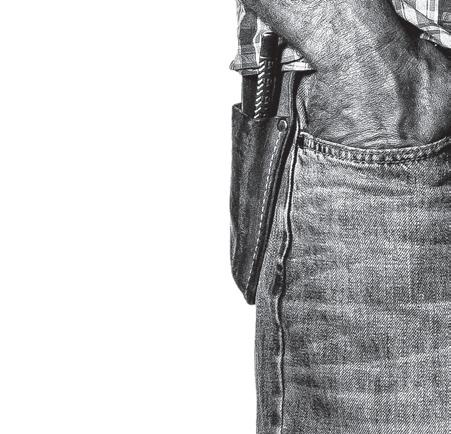Rooted in Research


get more with stine ® .


When it comes to soybean breeding, more generations equal additional yield — 2.2% more yield per generation. By introducing more new genetics faster than any other seed company, Stine delivers on the Stine Has Yield promise. For elite genetics paired with simple, flexible and effective weed control, plant Stine Enlist E3® soybeans.




LEARN MORE AT STINESEED.COM. 2.2% genetic gain calculation is based on evaluation of Enlist E3 elite genetics released 2020 to 2022. IMPORTANT: This ad is not intended to provide adequate information for use of these products. Read the label before using these products. Observe all label directions and precautions while using these products. TM ® SM Trademarks and service marks of Dow AgroSciences, DuPont or Pioneer, and their affiliated companies or their respective owners. The transgenic soybean event in Enlist E3® soybeans is jointly developed and owned by Dow AgroSciences LLC and M.S. Technologies L.L.C. ADVANTAGE
Download the Stine Seed app. The path to higher yields is now at your fingertips. Listen to the Stine podcast.
Executive Committee
President
Randy Miller, Lacona | D8
President-Elect
Suzanne Shirbroun, Farmersburg | D3
Secretary
Jeff Frank, Auburn | D4
Treasurer
Brent Swart, Spencer | D1
At-Large Director
Tom Adam, Harper | D9
Board of Directors
Chuck White, Spencer | D1
April Hemmes, Hampton | D2
Casey Schlichting, Clear Lake | D2
Rick Juchems, Plainfield | D3
Marty Danzer, Carroll | D4
Morey Hill, Madrid | D5
Dave Struthers, Collins | D5
Robb Ewoldt, Davenport | D6
Dave Walton, Wilton | D6
Scot Bailey, Anita | D7
Lee Brooke, Clarinda | D7
Warren Bachman, Osceola | D8
Pat Swanson, Ottumwa | D9
Tim Bardole, Rippey | At Large
Steph Essick, Dickens | At Large
Lindsay Greiner, Keota | At Large
Brent Renner, Klemme | At Large
American Soybean Association
Board of Directors
Steph Essick, Dickens
Wayne Fredericks, Osage
Morey Hill, Madrid
Jeff Jorgenson, Sidney
Pat Swanson, Ottumwa
Dave Walton, Wilton
United Soybean Board of Directors
Tim Bardole, Rippey
Robb Ewoldt, Davenport
Lindsay Greiner, Keota
April Hemmes, Hampton
Brent Renner, Klemme
Staff Credits
Editor | Bethany Baratta
Sr. Dir., Information & Education | Aaron Putze, APR
Photographer | Joclyn Bushman
Creative Design Coordinator | Susan Langman
Writer | Joseph Hopper
Writer | Jeff Hutton
Writer | Kriss Nelson
Public Relations Manager | Brock Johnston
Iowa Soybean Review is published monthly by:
Iowa Soybean Association
1255 SW Prairie Trail Parkway, Ankeny, Iowa 50023
(515) 251-8640 | iasoybeans.com
E-mail: bbaratta@iasoybeans.com
For advertising information contact Bethany Baratta at (515) 334-1020 or bbaratta@iasoybeans.com.
Comments and statewide news articles should be sent to the above address. Advertising space reservations must be made by the first day of the month preceding publication. In consideration of the acceptance of the advertisement, the agency and the advertiser must, in respect of the contents of the advertisement, indemnify and save the publisher harmless against any expense arising from claims or actions against the publisher because of the publication of the content of the advertisement.
FEBRUARY 2023 | Vol. 35, No. 5
8
Partners in Conservation
A partner-backed approach to improve soil health and water quality.
12
Retailers United
Anniversary celebrates more than a decade of research and focus on progress.
20
Myth Busting
Can you decipher myths from facts? Test your conservation knowledge.
26
Leveraging Checkoff Dollars
External funding and partnerships make farmer investments go further.
On the Cover: Iowa Soybean Association
Conservation Agronomist Ryan Johnson examines leaves in a soybean field. Johnson works closely with an ag retail partner in northwest Iowa to engage farmers in conservation programs and practices. He also provides agronomy and conservation expertise to farmers and helps them engage in state and federal cost share funding.
IOWA SOYBEAN REVIEW® | 3
Photo: Joseph Hopper
Executive Insights
Kirk Leeds, ISA Chief Executive Officer kleeds@iasoybeans.com

All About Growth
Much is said, written and discussed regarding the importance of growth. Key to growing personally and professionally is a willingness to invest the time and effort necessary to gain knowledge and new skills. This commitment strengthens abilities and capabilities and sharpens focus and resolve.
We’re known for growth here at the Iowa Soybean Association (ISA). It’s why I came to work for ISA 30 years ago and never left. We grow:
• Soybeans and market demand;
• Relationships with policymakers and food-minded Iowans;
• Farmer and Advocate membership;

• The number of farmers involved in carbon reduction programs;
• The pace and scale of environmental practices proven to improve water quality and soil health;
• Collaboration and cooperation with industry partners; and
• Our reach and influence.
Growth is synonymous with vitality and strength. It’s why ISA’s brand promise, “Driven to Deliver” is so on the mark.
Accomplishments don’t happen in a vacuum. They are people-driven. Farmers founded and fund ISA, determine the organization’s priority programs, and closely monitor activities and results. They engage with other farmers, industry leaders and policymakers to increase soybean production and demand.
A dedicated staff then takes the baton, leading our Supply, Demand, Information & Education and
Public Affairs committees and programming. With oversight by the ISA board, nationally recognized initiatives have been launched to better serve farmers. Examples include the Iowa Food & Family Project, Soy Transportation Coalition, North Central Soybean Research Program, Research Center for Farming Innovation, Iowa Biodiesel Board, Iowa Ag Water Alliance, Midwest Soybean Collaborative, AgOutcomes, Conservation Agronomy Network, Policy Leaders Fellowship and U.S. Soybean Research Collaborative.
As we identify new and innovative ways to serve soybean farmers, ISA’s office that opened its doors 12 years ago in Ankeny must also grow. This spring, construction will begin to add 12,000 additional square feet of space. It will be suitable for adding professional staff, hosting conferences and trade delegations, and fostering greater collaboration. Just like the original construction, the “new west wing” will be self-financed. It will feature geothermal and soybased building materials where appropriate and feasible. If all goes as planned, construction will be complete in 2024 and coincide with ISA’s 60th anniversary.
Cutting the ribbon on this new addition will be a tangible indicator of the soybean industry’s continued strength and vitality. Here’s to a very bright future for a people-first ISA and a soybean industry that’s always growing to make the most of opportunity – and, when necessary – create it.
4 | FEBRUARY 2023 | IASOYBEANS.COM
" Everyone wants to live on top of the mountain, but all the happiness and growth occurs while you’re climbing it."
Andy Rooney, radio and TV writer
SOYLEIC® is a non-GMO, high-oleic option for today’s soybean farmers — and those they serve.

• Maturity Groups for Your Area

• Competitive Yields
• Added Value for Culinary and Livestock Markets
That means the future of a healthier food system isn’t manufactured — it’s grown. See why soybean farmers are embracing SOYLEIC®
Consider a position on the ISA Board of Directors.
ISA is governed by a board of 22 volunteer farmerdirectors who meet throughout the year to develop ISA's policies and programs. Directors are elected by Iowa soybean farmers in July and take office in September. Want to learn more about this opportunity?
Scan the QR code to learn more or apply

soyleic.com
When the world relies on you for healthy food choices, rely on SOYLEIC ®
(573) 635-3819 734 S. Country Club Drive Jefferson City, MO 65109
Are you interested in shaping the future of the Iowa Soybean Association?
Better Breeding and Water Management Mitigate Weather Risk to Soy
BY AARON PUTZE, APR
Imagine if you could control the weather, like making it rain when it’s needed and stop when it’s not? Or ordering up some sun and warmth in April and May when wanting to plant (or golf!) and then dialing back the thermostat a degree or two in July and August? And wind? Let’s go with light and variable (especially in June when sprayers head to the fields).
OK, time to wake up.
While controlling the weather remains just a dream, managing it to the benefit of soybean production and profitability is reality.
Joshua Elliott combines climate and ag science to forecast agricultural development and opportunity. In comments to United Soybean Board directors gathered recently in St. Charles, Missouri, the founder and CEO of Praedictus simplified the complex.

“I tell stories about a changing climate that you rarely hear,” says Elliott. “Put another way, I offer information that’s useful and applicable, rather than passing along trajectories and theories.”
While many talking heads peddle doomsday scenarios, Elliott is a self-described realist.
Not all changes in the weather and climate are created equal, he says. In fact, many regions and commodities stand to benefit from moderating temperatures, including soybeans.
“There will be winners and losers as there always are with weather and agriculture,” says Elliott. “Soybeans can realize a significant comparative advantage in the next few decades compared to other crops, especially if we improve plant breeding and water management.”
Global greenhouse gas (GHG) emission increases have moderated the past two years due to COVID lockdowns, Elliott says. Because GHG trap energy (much of which is stored in the ocean), 80% of the climate we’ll experience through 2050 is already baked in, he says.
Soybean yields, he predicts, will continue to trend higher through 2050.
“CO2 effects on a crop that fixes its own nitrogen are helpful, so the soybean stands to benefit. It receives maximum growth benefits compared to corn and wheat.”
6 | FEBRUARY 2023 | IASOYBEANS.COM
Photo courtesy of the United Soybean Board
With improved water management and efficiency by crops, most negative impacts perpetuated by warming temperatures can also be mitigated.
North Dakota and Minnesota soybean farmers stand to benefit most as temperatures moderate northward.

Rainfall amounts will remain variable while water demand will increase nearly everywhere, says Elliott.
“Even if you do get more rain, it will come too early in the season or be too much at one time to be beneficial. A premium will be placed on improved water retention and management.”
Extreme, large scale weather events will increase in frequency over the next 25 years. The number of two-day extreme precipitation events are already on the rise.
“We’re receiving more rainfall but primarily in the spring and courtesy of extreme weather events,” says Elliott. “This is impacting the timely planting and harvesting of crops and impact yields.”
He also predicts the prevalence of extreme and longlasting temperature swings, including heat waves. This is expected to increase over the coming decades, particularly in the southern United States.
Farms currently irrigating will need more water or better water management as crops demand more due to increased evaporation and transpiration. Elliott says modeling pegs the increase at 15% to maintain baseline yields.
“Water availability will be at a premium the next 25 years,” he adds. “With irrigation, you cancel out negative impacts and turn the elevated temperatures into a benefit.
“The question: Can improvements in plant breeding and water management keep pace?”
Contact Aaron Putze at aputze@iasoybeans.com
processor
your
www.agp.com
cooperative soybean
" Soybeans can realize a significant comparative advantage in the next few decades compared to other crops, especially if we improve plant breeding and water management."
Joshua Elliott, CEO of Praedictus
Partners in Conservation
Growing popularity in partner-driven conservation enhances natural resources
BY BROCK JOHNSTON
With conservation funding assistance and publicprivate collaboration on the rise, it’s no surprise Regional Conservation Partnership Program (RCPP) projects awarded through the U.S. Department of Agriculture’s Natural Resources Conservation Service (USDA-NRCS) are quickly becoming a popular option for farmers and landowners to meet their stewardship goals.
“RCPP is a partner-driven approach to conservation,” says Ben Porepp, conservation agronomist at the Iowa Soybean Association (ISA). Through the program, NRCS co-invests with partners, including commodity groups, ag retailers, city municipalities and others, to implement projects that provide solutions to conservation challenges on agricultural land in priority watersheds in Iowa.
“Currently, there are nine unique RCPP projects active in Iowa,” says Porepp. The number of projects is expected to grow as the adoption of conservation practices climbs in the state, including cover crop integration.
“Every RCPP is variable in the practices made available to implement, but a vast majority will offer cover crop cost-share, no-till, strip-till and basic edge-offield techniques,” says Porepp. Additional opportunities can include buffer strips, habitat restoration and more.
These practices, supported by years of research, will also help the state of Iowa meet its obligations under the Iowa Nutrient Reduction Strategy to reduce nitrate loading to the Mississippi River.
North Raccoon Watershed
One RCPP covering the North Raccoon Watershed — the North Raccoon Partnership for Soil and Water Outcomes — is using the partner-backed approach to improve soil health and water quality resulting in reduced nutrient and sediment volumes.

ISA, alongside 11 partner organizations, including ag retailers, federal and state agencies, and the City of Des Moines, partnered in 2021 to establish conservation practices and systems collaboratively with farmers and landowners. The effort aimed to deliver measurable improvements and outcomes for water quality and soil health.
Initiated in 2021, the project boundary spans 10 Iowa counties, including portions of Boone, Buena Vista, Calhoun, Carroll, Dallas, Greene, Pocahontas, Polk, Sac and Webster.
“Our main resource concerns in the North Raccoon is nitrate exports from the watershed — nutrient leaching impacting water quality,” says Porepp. “Soil erosion and habitat restoration also top the list of areas we’re seeking to improve by working directly with farmers, landowners and other watershed stakeholders, both upstream and downstream, to make these improvements.”
These efforts are made possible through more than $16 million in partner contributions, leveraged with $9.8 million in RCPP funds.
To date, the North Raccoon Partnership for Soil and Water Outcomes RCPP has awarded 13 contracts within the project boundary, totaling more than $250,000. An estimated 47 additional applications were received in 2022, kicking the project off toward the goals of adopting:
• 50,000 additional cover crop acres;
• 19,200 acres of reduced tillage;
• 22 bioreactors;
• 20 oxbow wetland restorations;
• 25 saturated buffers; and
• 5 nutrient removal wetlands.
8 | FEBRUARY 2023 | IASOYBEANS.COM
Ben Porepp, ISA conservation agronomist
Cedar River Watershed
The Cedar River Watershed, spanning portions of 23 eastern Iowa counties, has also been identified as a priority watershed for similar water quality improvements. With ISA and additional partner support, the City of Cedar Rapids is leading efforts to improve water quality, protect drinking water and mitigate flood risk through the Cedar River Source Water Partnership.
The project aims to establish in-field practices in tandem with edge-of-field practices to improve water quality, reduce flood risk and greenhouse gas emissions, and protect source water. Drought resilience, reduced erosion and improved soil health are additional benefits from implementing these strategies.

ISA Conservation Agronomist Evan Brehm, positioned within the watershed at ag retailer Linn Cooperative, says
ISA’s team of conservation agronomists can assist farmers in finding the right opportunities for meeting unique stewardship and profitability goals.
“RCPP project boundaries often overlap in geography and can offer different conservation strategies,” Brehm says. “Our team serves as a resource network, providing assistance and support to help stakeholders understand what opportunities are available to them.”
Getting started
Farmers and landowners interested in establishing practices in 2023 through all RCCP projects statewide should apply by Friday, March 17. Sign up and financial assistance are administrated through local NRCS offices. Contact your local conservation agronomist or soil and water conservation district for assistance. Applications from farmers and landowners residing in the North Raccoon River Watershed will continue to be accepted in an ongoing sign up. Applications received after the March 17 deadline will be eligible for consideration at a future date.
Interested in learning more about these opportunities? Contact Ben Porepp, ISA conservation agronomist at bporepp@iasoybeans.com or 515-802-2264.
Contact Brock Johnston at bjohnston@iasoybeans.com
IOWA SOYBEAN REVIEW® | 9 Is your farmland RCPP eligible? Location Acres are within the project boundary Land status Acres are not enrolled in another NRCS primary program Practices Practices available for cost-share align with farm operation goals
Chantelle Collier/Shutterstock.com
Meet the Director Scot Bailey
Location: Anita
Title: District 7 Director
ISA Committees: Public Affairs, Demand
What crops and livestock do you grow and raise on the farm?
Soybeans, corn, cattle, sheep, pasture and hay.
What makes your farm unique?
We seed down marginal ground for hay or pasture and use no-till and strip-till. In the spring, we use fertilizer closer to when the crop needs the nutrients.
What does success mean to you on the farm?

Being able to pass the farm on to the next generation.
How do you envision production agriculture 50 years from now?
It’ll be about taking care of every acre on the farm differently.
What do you see as the largest hurdle for homegrown soybeans in the future? Opportunity?
Educating the public about GMOs and their benefits. Soybean oil is a huge opportunity.
What’s something people don’t usually know about you?
I was born in Germany, I’m lefthanded, and I always want to make things better or more efficient.
10 | FEBRUARY 2023 | IASOYBEANS.COM
Full-Circle Return
HERE’S HOW THE SOY CHECKOFF WORKS. The national soy checkoff was created as part of the 1990 Farm Bill. The Act & Order that created the soy checkoff requires that all soybean farmers pay into the soy checkoff at the first point of purchase. These funds are then used for promotion, research and education at both the state and national level.
FARMERSSELLBEANS TO ELEVATORS, PROCESSORS&DEALERS
1/2 of 1% of the total selling price collected per the national soybean act & order
Half goes to the state checkoff for investment in areas that are a priority for that state.
EDUCATION RESEARCH PROMOTION
ROI TO THE FARMER
Half goes to the national checkoff for investment in USB’s long-range strategic plan.
unitedsoybean.org











 Led by 73 volunteer soybean farmers, the United Soybean Board (USB) invests and leverages soy checkoff dollars to MAXIMIZE PROFIT OPPORTUNITIES for all U.S. soybean farmers.
Led by 73 volunteer soybean farmers, the United Soybean Board (USB) invests and leverages soy checkoff dollars to MAXIMIZE PROFIT OPPORTUNITIES for all U.S. soybean farmers.
* *
0.5%
ACWA Marks Nutrient Reduction Strategy Anniversary
Organization’s water improvement efforts in place well before strategy was implemented
BY JEFF HUTTON
The 10-year anniversary of the Iowa Nutrient Reduction Strategy is drawing near, and there are plenty of success stories about farmers protecting waterways and water sources.
But if you ask Roger Wolf, those efforts began well before 2013, when the strategy officially got under way.
Historical perspective
Wolf, executive director of Agriculture’s Clean Water Alliance (ACWA), says work on nutrient reduction began in earnest 20 to 30 years ago. ACWA, the Iowa Soybean Association (ISA), Iowa State University (ISU) and other organizations and entities have had a long history of taking action to address water quality concerns.
“Sometimes, I don’t think people recognize the prelude that went into the nutrient reduction strategy,” Wolf says.
Agricultural retailers, though in direct competition, united in the goal of improving and protecting water quality through the creation of ACWA in 1999. The members formed a 501(c)3, and went to work in the Raccoon River and Des Moines River watersheds.
Members have been focused on long-term implications on source water issues, nitrate removal and various practices that improve water quality.
Concurrently, the Mississippi River/Gulf of Mexico Hypoxia Task Force was created. At the time, Patty Judge, Iowa’s Secretary of Agriculture, was part of this task force, which came up with an action plan.
“Around 2012, some of us met with the agencies, and ISU was articulating its science assessment – explaining
various scenarios of practice adoption, associated costs and opportunities,” Wolf says.
At that time, there was a convergence with business and industry, municipalities and others about coming together with agriculture to begin working on a strategy.
This coincided with the U.S. Environmental Protection Agency’s (EPA) efforts, beginning with a framework that encouraged states, EPA and stakeholders to work in partnership to accelerate the reduction of nitrogen and phosphorus loading in the nation’s waters.
The memo included elements that would be part of the nutrient reduction strategy with themes of implementation using robust scientific information.
Building bridges
ACWA, Wolf says, built bridges of cooperation between co-ops, ag retailers and farmers to work on water quality while also continuing practices that enabled farmers to be productive and profitable.
“ACWA was collecting data on nitrogen loss and its impact on the water, providing guidance on where to start working in the watershed,” he says. “This was way before the Iowa Nutrient Reduction Strategy was implemented.”

These efforts also shined a spotlight on ag retailers coming together to do a “little bit of self-policing and taking accountability,” Wolf says.
ACWA’s work along with the nutrient reduction strategy is a testament to protecting Iowa’s waterways and water sources, while also allowing farmers to remain prosperous and profitable.
12 | FEBRUARY 2023 | IASOYBEANS.COM
" Protecting Iowa’s water sources and farmer productivity can co-exist."
Roger Wolf, executive director, Agriculture’s Clean Water Alliance (ACWA)
“Protecting Iowa’s water sources and farmer productivity can co-exist,” says Wolf. “That’s our desire.”
Despite the implementation of cover crops, bioreactors and the establishment of wetlands strategically located across Iowa, some critics say the work that has occurred over the course of the strategy’s implementation 10 years ago isn’t enough.



“We know there are critics who say we’re not making progress fast enough,” Wolf adds. “I remind people that progress is commensurate with the rate of investment — more resources equal more engagement and progress.”
At one time, the strategy was estimated to cost upward of $4 billion to implement the non-point source practices necessary to achieve the goals, according to Wolf.
“We started thinking about the economic profile of agriculture in Iowa and that $4 billion might be 10-15% of the annual value of the ag industry — so maybe that’s not outlandish,” he says. “The big challenge is where the money can come from and how long will it take to realize this level of investment and action.”
The future
Substantive changes to water quality don’t happen overnight, Wolf says.
“The ACWA has made progress,” he says. “Is it enough? No. Is it fast enough? No. But in my opinion, back in 2013, Iowa was one of the first states to roll out a strategy, and address water quality issues in a coordinated manner.
“We’re coming to terms with the scope, scale and magnitude of nutrient loss and water issues; we’re fighting the good fight.”
In 2021, ACWA’s initiative expanded statewide. But the goals are the same: to reduce nutrient loss and improve water quality.
From collecting data and information; working with researchers and partners; supporting farmers with technical and financial assistance; providing products service and technologies that work; and creating other co-benefits with biodiversity, fish habitats and others, ACWA membership is doing the work the Iowa Nutrient Reduction Strategy calls for.
“I think ag retail is learning from the early years about how they can participate in a substantive way on a bigger scale,” he says. “It’s not just nutrient reduction, it’s sustainability up and down the supply chain, climate-smart practices, and farm and landscape resiliency.”
Wolf says ACWA members and partners are focused on retail conservation and helping farmers make practical changes that others can see firsthand.
ACWA members, he says, are utilizing their “trusted working relationship with farmers and providing the horsepower and leadership to putting their money where their mouths are.”
For more information about ACWA, go to acwaiowa.com.
Contact Jeff Hutton at jhutton@iasoybeans.com
IOWA SOYBEAN REVIEW® | 13
ACWA’s efforts in reducing nutrient loss and improving water quality were in action before the Iowa Nutrient Reduction Strategy was rolled out in 2013.
WISHH catches new markets for U.S. soy by advancing aquaculture. soy by

ASA/WISHH is helping explore opportunities for soy-based feeds to grow aquaculture in 8 sub-Saharan African countries, including Ghana, Nigeria, Senegal, Togo, Burkina Faso, Uganda, Kenya, Tanzania

Connect with WISHH
wishh.org
WISHH is a program of the American
and is funded in part by the United
and state
board checkoff programs.
Soybean Association
Soybean Board
soybean


IOWA SOYBEAN REVIEW® | 15
graduates entrepreneurs from global training for high-quality foods and feeds.
WISHH is a program of the American Soybean Association and is funded in part by the United Soybean Board and state soybean board checkoff programs. Connect with WISHH wishh.org ASA/WISHH
WISHH
from for
What We Learned About Cover Crops in 2022
BY KRISS NELSON
Iowa Soybean Association (ISA) Senior Field Services Program Manager Scott Nelson is looking through data from the 2022 growing season as he prepares to assist producers with their cover crop management practices in 2023.
It was a year of highs and lows, considering weather conditions that varied throughout the state.
Termination issues
Last spring, Nelson says there were issues with terminating cover crops mainly due to conditions not conducive to a glyphosate burndown.
“Glyphosate is the most common herbicide used to terminate cover crops. It works slowly in cloudy, cold weather allowing the cover crop to grow and get large,” he says. “It will eventually die, but the kill is slower.”
Cover crop termination was an issue for West Branch farmer Jake Pedersen last spring.
Pedersen farms alongside his father and brother, raising 2,200 acres of corn and soybeans. They have been using cereal rye to cover 100% of their acres for the past three years after introducing cover crops into their operation eight years ago.
The cool, wet conditions deterred Pedersen from a timely glyphosate application, causing his rye in one field to grow to 18 inches before he could terminate, ultimately resulting in a 40-bushel yield drag in corn.
Pedersen learned from the 2022 crop year; if weather conditions allow, he’ll spray sooner in the season to terminate the cereal rye. He’s more comfortable with cereal rye growing eight- to 10 inches in height before terminating.


If producers are in the same predicament this spring, Nelson urges them to consider a tank mix to partner with their glyphosate.
“Cover crops add a whole level of management, and you need to be flexible." Pedersen says. "The more times you try, learn and share your experiences, the more you can hopefully minimize mistakes.”
Cover crop blends
To help producers diversify their cover crop acres, ISA conservation and regional agronomists research various cover crop blends to develop systems that raise cash crop yields.
“Scientific literature shows various species of cover crops help to improve yield, but there have been little to no on-farm characterizations in Iowa,” says Nelson. “We seeded micro plots across the state with different species and blends to see what survives over the winter.”
Pedersen is working with Nelson to help introduce camelina, hoping it will thrive and add some diversity to their cereal rye cover crop.
“We are doing our best to replicate the whole gamut of what nature provides and reap the benefits while still trying to manage any impact on our cash crop,” Pedersen says.
16 | FEBRUARY 2023 | IASOYBEANS.COM
Jake Pedersen says working with Iowa Soybean Association agronomists has expanded his knowledge and efforts in growing cover crops on his West Branch farm.
Frost-seeding cover crops
Producers in abnormally dry areas that may not have had a successful fall seeding of their cover crops could still have an opportunity to benefit from cover crops.
Nelson and the team at ISA have been looking into the potential value of frost-seeding cover crops in late March or early April.
“There could be time for a cover crop of oats, annual rye or cereal rye to grow to a good height before planting soybeans,” Nelson says. “This could give you an advantage for improving soil health and creating root channels for summer rain infiltration or weed control from the biomass.”
Having a cover crop prevalent in fields during the spring can also help sequester any nitrogen that would otherwise be lost to production.
Nelson says cover crops in a soybean-corn rotation can be especially valuable.
“Planting cover crops ahead of growing soybeans is valuable, especially with drought conditions because there is likely nitrogen left over from the corn,” he says. “If we can sequester nitrogen with oats or some species of grass ahead of the soybeans, the nitrogen will be stabilized in the early spring and available for soybeans later in the season when it needs it. Frost-seeding is a good way to maintain your nitrogen investment from 2022.”
Weed control
Cover crops continue to play an essential role in inhibiting herbicide-resistant weeds in soybeans, Nelson says.
Using the biomass left over after terminating cover crops requires proper management. Nelson recommends allowing the cover crop to grow eight- to 12 inches tall in the spring before termination.
“In my opinion, this growth is the safest, surest way you can get good biomass and root channels to infiltrate rain,” he says.
Nitrogen stabilization
Cover crops can work as a nitrogen stabilizer as the growing plants can soak up the available nitrogen from early-season manure applications — especially if manure is applied to warmer soils — and preserve it over the winter.
“We cover our soybean stubble with manure,” says Pedersen. “Our goal is to apply manure and seed the rye to ensure we are trapping some of those nutrients by keeping something growing in place.”
His soybean crop is reaping the benefits of the combination of manure application and cover crops. Eighteen months after a manure application — and after a season of growing corn — he’s seen yield bumps in his soybean crops.
“We had our highest soybean average in 2021 and beat that in 2022,” Pedersen says.
He’s working with Nelson to determine if cover crops are sequestering leftover nitrogen from the manure that the corn crop didn’t utilize and releasing it to the soybean crops when the plants need it.
Not only can cover crops help sequester nitrates, they may also help alleviate a large problem associated with manure applications: compaction.
“Cover crops can break up the compaction to improve soil tilth and increase water infiltration,” Nelson says. “We are learning more about how important cover crops are in manure applications.”
Cover crop trial opportunities
The ISA team at the Research Center for Farming Innovation (RCFI) is ready to work with farmers on in-field research trials.
“We know soybeans work in a cover crops system. We know we have better soil health, increased water quality and more nitrogen recycled, but sometimes we don’t see a yield advantage,” Nelson says.
The RCFI team wants to help farmers determine the potential.
“Many farmers aren’t concerned, however, because of the profit advantage from the weed control angle. We think there should be a yield advantage, and we would like to work with farmers to understand and realize this potential.”
Contact Kriss Nelson at knelson@iasoybeans.com
IOWA SOYBEAN REVIEW® | 17
" Cover crops add a whole level of management, and you need to be flexible. The more times you try, learn and share your experiences, the more you can hopefully minimize mistakes."
Jake Pedersen, West Branch farmer
SOY SNAPS
BY JOCLYN BUSHMAN



 Red barns adorned with festive wreaths near Decorah
Dixson Frye and his dog near Independence
An old tractor sits while a blanket of snow covers the ground near Eldorado
Red barns adorned with festive wreaths near Decorah
Dixson Frye and his dog near Independence
An old tractor sits while a blanket of snow covers the ground near Eldorado
18 | FEBRUARY 2023 | IASOYBEANS.COM
Winter pony outside of West Liberty





 Dan Venteicher in a field near Edgewood
A cozy International Harvester sits inside near Ridgeway
Bill Couser stands at his farm near Nevada
Snowy barn near Highlandville
Ashley and Layne Kaldenberg check on a new friend near Albia
Dan Venteicher in a field near Edgewood
A cozy International Harvester sits inside near Ridgeway
Bill Couser stands at his farm near Nevada
Snowy barn near Highlandville
Ashley and Layne Kaldenberg check on a new friend near Albia
IOWA SOYBEAN REVIEW® | 19
An old hay barn sits in the rolling hills of northeast Iowa near Festina
The Iowa Nutrient Reduction Strategy (Iowa NRS) turns 10 this year. It’s a scientific framework to reduce nutrient losses, and the Iowa Ag Water Alliance is a key partner in helping achieve that goal. While Iowa farmers have been implementing and innovating conservation practices long before the adoption of the Iowa NRS, there are still a lot of misconceptions about conservation practices. Can you tell myth from fact?
Myth or Fact: Cover crop adoption has increased by 344% since 2016. FACT.
Yes, you can grow cover crops in Iowa. According to data from the Iowa Nutrient Research and Education Council and Iowa NRS, cover crop acres in the state increased from 623,000 acres in 2016 to nearly 2.8 million acres in
2021. Rye remains the most popular cover crop because it’s easy to grow and terminate. It’s also forgiving. Rye that’s established in the fall will overwinter and provide cover in the spring ahead of planting, which keeps your soil where you want it and reduces nutrient loss.
Myth or Fact:
Conservation practices aren’t profitable. MYTH.

In-field conservation practices like cover crops and no-till can save farmers money.
“In front of soybeans, cover crops play a key role in suppressing herbicide resistant weeds,” says Scott Nelson, Iowa Soybean Association (ISA) senior field services manager. “Using notill means less wear and tear on machinery and saves in fuel costs.”
BY KAITLIN LITTLE
Myth or Fact: Bioreactors, saturated buffers and water quality wetlands are new practices in Iowa. MYTH
Iowa farmers lead the nation in the number of installed water quality wetlands, saturated buffers and bioreactors. These are all strategies placed on the edges of fields to filter water before it moves downstream. According to the Iowa Department of Ag and Land Stewardship, there are more than 125 water quality wetland sites, 150 saturated buffers, and 100 bioreactors in the state.
ISA has played a major role in pioneering these edge-of-field practices. ISA and Iowa State University (ISU) worked together to help develop the NRCS practice standard for bioreactors, and ISA was one of the first to “recharge”
20 | FEBRUARY 2023 | IASOYBEANS.COM
a bioreactor that was originally installed in 2008 — replacing the old wood chips with new. ISA has also worked with ISU to make these structures low maintenance for farmers.
Myth or Fact: Fertilizer efficiency in the field is impacted by billions of possible factor combinations, including soil type, weather and cropping system. FACT.
“Research shows that the optimum rate of nitrogen (N) can vary by more than 100% from field to field and year to year,” says Dr. Mike Castellano, ISU agronomy professor.

Dr. Castellano heads up the Iowa Nitrogen Initiative, which addresses these field-to-field and year-to-year differences through on-farm nitrogen trials. The data produced will be used to create
tools that will help farmers save money by helping them decide the most efficient amount of fertilizer. While these tools are under development, farmers can soil test for residual nitrate levels to better estimate how much N to apply each season. Farmers interested in participating in the Iowa Nitrogen Initiative can reach out to an ISA conservation agronomist to learn more.
Myth or Fact: Farmers, hunters, neighbors and wildlife all benefit from water quality wetlands. FACT.
Wetlands provide multiple benefits such as more habitat for pollinators and wildlife, which also benefits hunters, and improves water quality for neighbors. Farmers benefit, too. These wetlands take minimal land out of production and treat, on average, 52% of nitrates from field tile.
For example: Mark Mueller, a farmer in Bremer County, installed a water quality wetland in 2022. This wetland is on what is called a breakpoint site that was historically wet with lower yields. Installing a wetland in a less productive spot means cost savings for Mueller over time because inputs aren’t being wasted. Mueller’s water quality wetland is only 2.86 acres, but it treats 446 acres.
“Whether 100 miles downstream or 100 years in the future, this wetland will remove nitrates and clean up the water for the benefit of generations not yet born,” says Mueller.
Contributed by Iowa Agriculture Water Alliance (IAWA). IAWA is partially funded by Iowa Soybean Checkoff and was founded by ISA, Iowa Corn Growers Association and Iowa Pork Producers Association.
IOWA SOYBEAN REVIEW® | 21
Sharing Drainage Research
International Drainage Symposium comes to Iowa
BY JOSEPH HOPPER
In November 2022, planet Earth reached a total population of more than 8 billion people. It’s an astounding number. While the total number of people on the planet has continued to trend higher, the total amount of land used for agriculture in the United States has trended the opposite way in the last 50 years. Iowa soybean farmers and farmers across the country are producing more than ever before on the land. One of the key factors is drainage.
Agricultural land drainage dates back thousands of years — many times being an ignored, underrated part of farming. The first farmer to utilize drainage tile in the United States, John Johnston of Seneca County, New York, was laughed at and ridiculed by his neighbors back in 1838. That was until they heard about the new yields on his formerly unproductive ground. Things have changed since then.
In 1965, the American Society of Agricultural Engineers met in Chicago for its first specialty conference on drainage, where agriculture’s best and brightest discussed things like the new corrugated-wall plastic drainage, which would mark the current era of ag drainage in America. Today, nearly one-third of all agricultural land has drainage on it, and it represents some of the most productive land.
But it’s not without challenges — nutrient loss has become a hot topic in an increasingly climate-concerned world. Luckily, the drainage meetings first held in
1965 continue to bring agriculture’s brightest scientists and engineers together every five to six years for the International Drainage Symposium to discuss the latest advancements in drainage and look to the future.
An Iowa first
Last summer, the 11th International Drainage Symposium came to Iowa for the first time and was co-chaired by Iowa Soybean Association Senior Research Scientist Dr. Chris Hay and Iowa State University’s Dr. Matt Helmers. Hay says Iowa was a prime location to discuss ag drainage.
“Iowa is certainly one of the leaders in the U.S., which is trying to address nutrient reduction and edge-of-field practices,” Hay says. “We have the most bioreactors and saturated buffers of any of the states in the Midwest, and we’re a leader of nutrient treatment wetlands.

“We can contrast our voluntary approach with that of European countries who are on a regulatory system. Both approaches have had its own issues, some things that have worked well and some that haven’t worked as well. Getting together internationally with different people working with various systems and geographies is great because we can share our successes and lessons learned.”
More than 200 people attended the 11th International Drainage Symposium, representing 23 states and 11 countries. There were 104 scientific presentations; the
Alleman Creek in Polk County is one research site regarding the feasibility of using automated control structures for combined controlled drainage and saturated buffer systems.
22 | FEBRUARY 2023 | IASOYBEANS.COM
symposium’s theme was, “Advancing drainage to meet a changing climate.”
“The theme of the symposium reflected both the physical climate and weather, and the changing political and social climate around drainage and water quality,” Hay says.
During a panel discussion, representatives from academia and industry, drainage contractors and practitioners, and a climatologist discussed some of the changes to climate and the impact on drainage. A drainage contractor from England shared his experience working in the U.K. He also connected what he learned studying drainage in a number of countries during his time as a Nuffield Scholar.
Charolette Kjaergaard, with NovaDrain Aps of Denmark, also addressed the audience. She helped develop Denmark’s national strategy for drainage edge-of-field practices.
“It was an interesting comparison to the U.S. and other countries as we all struggle with how best to meet our nutrient reduction goals,” Hay says.
The group of scientists spent part of the symposium touring Hay’s and Helmers’ ongoing multi-year research into drainage water recycling in Iowa.

“In a nutshell, the system captures drainage water in the spring and stores it, so we’re capturing water when we’ve got too much and reusing it as supplemental in the summer when we can often use more,” Hay says. “It gives us multiple benefits, including crops benefit from supplemental irrigation, which gives farmers greater and more consistent yields and resilience during drought periods.”
Hay adds, “From a public benefit view, we also have water quality benefits. We’re recycling water and nutrients that would have otherwise gone downstream.”
After years of preparation and planning through a pandemic, and then finally putting a successful symposium in the books, Hay says he’s thankful.
“To have great attendance with a lot of positive feedback and success from the symposium shows people were happy
to be back together and to catch up with colleagues,” He says. "Being able to see and hear what everyone’s been doing and to learn from each other is gratifying.”
Contact Joseph Hopper at jopper@iasoybeans.com
IOWA SOYBEAN REVIEW® | 23
" There were talks and presentations offering a wide range of subjects, often about research or exciting new developments. The field days were especially good to see the conservation practices in action in real world settings rather than in photos or labs."
Rob Burtonshaw, participant from the U.K.
Dr. Chris Hay and Gabe Johnson, Iowa State University graduate student, prepare to collect a water quality sample from one of the monitoring wells in a saturated buffer in Polk County.
Join WISHH in the business of untapped protein potential.
WISHH connects trade and development across global market systems, improves food security, and brings the power of strategic partnerships to our unique market-systems approach.

Connect with WISHH wishh.org
WISHH is a program of the American Soybean Association and is funded in part by the United Soybean Board and state soybean board checkoff programs.

24 | FEBRUARY 2023 | IASOYBEANS.COM
Farmland Values Highest Since the 1940s
BY BETHANY BARATTA
High commodity prices, limited land supply and low-interest rates through the summer of 2022 helped push average Iowa farmland values up 17% over 2021 values.

Results from Iowa State University’s Land Value Survey, issued recently by ISU’s Center for Agricultural and Rural Development, show the average value of an acre of Iowa farmland rose 17% more than the past year to $11,411 per acre as of Nov. 1, 2022. All nine crop reporting districts in the state showed an increase in farmland values.
Record values
The 17% increase followed a 29% surge in the farmland values in 2021. The $11,411 per acre nominal land value is the highest since the 1940s.
The 2022 nominal land value is 31% higher than the 2013 peak in nominal land values, and the inflation-adjusted value, $9,088 per acre in 2015 dollars, saw a 9% increase and is also the highest on record.
The 2022 survey results are based on 668 county-level value estimates provided by 443 agricultural professionals, mostly ag lenders and broker/realtors. Started in 1941, the survey is the only one that provides estimates for all of Iowa’s 99 counties. The survey has been conducted by the Center for Agricultural and Rural Development in the Department of Economics at Iowa State University and Iowa State University Extension and Outreach since 2014.
Factors influencing growth
The continuing growth in value is supported by higher commodity prices,
limited land supply and low-interest rates through the summer of 2022. Readily available cash and credit, stronger-thanexpected crop yields, a good farm economy and strong demand for land, including from investors, were also factors.
Survey respondents noted concern about higher interest rates and input costs, stock market and economic uncertainty, weather and COVID concerns. In general, survey respondents were still optimistic about the strength of the future land market, with nearly half of respondents forecasting a continued increase in Iowa land values.
The most significant percentage increases were in the northwest and southwest districts, 22.3% and 22.2%, respectively.
The southcentral and southeast districts saw the smallest percentage changes and reported increases at or above 10%.
Across land quality classes, mediumquality land saw the most significant growth, 17.7%, while high- and lowquality land experienced 16.8% and 15.2% increases, respectively.
All 99 counties reported the highest nominal land values since 1950; for 66 counties, the inflation-adjusted values are also record-high — even higher than the previous peak in 2013. Mills, Fremont, Page, and Montgomery counties reported the largest percentage increases of 21.6%. Appanoose, Decatur, Lucas and Wayne Counties reported the lowest percentage increase of 10%.
Contact Bethany Baratta at bbaratta@iasoybeans.com
maxbelchenko/Shutterstock.com IOWA SOYBEAN REVIEW® | 25
Leveraging Checkoff Investments for Real Results
 BY
BY
The Iowa Soybean Association’s (ISA) Research Center for Farming Innovation (RCFI) continues to find ways to help soybean farmers be productive, profitable and sustainable.
They’re able to achieve these goals by leveraging soybean checkoff dollars and finding additional funding and partnership resources that help farmers with innovative research, tools and technical support.
Resources and relationships
For every $1 of checkoff revenue received from Iowa soybean farmers, 13 cents are allocated to research. About half of that (6 cents) goes to support the work of the RCFI team. Todd Sutphin, RCFI senior research program manager, says the center leverages non-checkoff funding resources at levels as high as two times the amount.
“We utilize the checkoff to secure additional funding, which involves state, federal and private grants,” he says. Having checkoff dollars allows RCFI to obtain
grants that have matching requirements. For example for every $1 in checkoff funds, RCFI often receives $2. Sutphin compared leveraging checkoff dollars to diversifying one’s stock portfolio.
Beyond the money, however, it allows RCFI to build partnerships. “We have great partners and can do more as a team than ISA alone,” Sutphin says.
“With these partnerships, we’re not just going after funding. The programs must be mutually aligned for our farmer members’ profitability, production and sustainability goals.”
Growing list of projects
Sutphin says RCFI’s efforts have grown over the years.
“In the early days of our on-farm research, we were doing research others were not doing,” he says.
“But today, more entities are doing that same work. The space is more competitive to go after ag research dollars.”
RCFI is the standard-bearer for research and helping farmers become more productive
JEFF HUTTON
" When you think about where to go for information, ISA has become a trusted resource for data information and unbiased research. RCFI has the platform to do unbiased research."
26 | FEBRUARY 2023 | IASOYBEANS.COM
Todd Sutphin, RCFI senior research program manager
Sutphin says RCFI continues its work by doing a variety of research, including:
• Studying cover crops for improved soil health and water quality;
• Developing online agronomic decision-making applications;
• Reducing costs and improving management efforts through datadriven simulation tools;
• Planning watersheds and highlighting its long-term value;
• Researching drainage water recycling;
• Studying pest management solutions; and
• Adapting and building resilience in nitrogen fertilizer management.
Future efforts
So, what does the next 5-10 years look like for RCFI?
Bigger projects and greater engagement with farmers in the state. “Bigger projects have value and bring on more trials statewide that answer farmers’ questions," Sutphin says.
“As we evolve into the conservation agronomist area, there is real potential to grow. In the last five years, we’ve seen the value of ag retailers to both field agronomists and conservation agronomists.”
While many farmers are using practices that are directionally correct, RCFI has data that can be validated on the farm. This offers informative feedback on those practices to help farmers improve.
ISA District 1 Director and Farmer-member Chuck White from Clay County agrees.
“RCFI really shines,” he says. “They get farmers to participate and have the data they need.
“Every year, I look for new ways to test products. RCFI gives me an idea if these practices will work on my farm or how the data or practice might contribute to the entire state. RCFI has the staff to get these projects implemented, and they have the analytics.”
White says RCFI trials are thorough.
“You have to have multiyear trials,” he says. “The
nice thing about RCFI is that they provide more than just one year of data.
“While it means research outcomes might not be immediately available, the outcome and information provided to farmers proves RCFI’s efforts are time well spent, White says. "RCFI lets us know if something is a good investment.”
Farmer supported
“When I came to ISA 20 years ago, we had a lot of ideas of things we wanted to implement, all in the name of farmers improving their bottom line and stewardship practices,” says Sutphin.
“We’ve put those plans into action and have seen farmers become profitable, along with improving water quality and soil health.”
Those efforts have been recognized by White and others.
“I’m proud that ISA has become a respected party in the discussion around conservation and agronomy,” Sutphin says. “When you think about where to go for information, ISA has become a trusted resource for data information and unbiased research. RCFI has the platform to do unbiased research.”
With an average of 60 to 80 projects under way each year, those ISA projects highlight the importance of leveraging checkoff dollars into tangible results.
“We’ve gone after non-checkoff funding on behalf of farmers to do more for Iowa farmers,” says Sutphin. “It’s a big deal to have those leveraged dollars to go above and beyond the checkoff.”
For more information on RCFI, go to: iasoybeans.com/research/about-rcfi.
Contact Jeff Hutton at jhutton@iasoybeans.com
IOWA SOYBEAN REVIEW® | 27
" RCFI gives me an idea if these practices will work on my farm or how the data or practice might contribute to the entire state."
Chuck White, ISA District 1 director and farmer-member
Plan, Do, Check, Act
Implement a continuous improvement process for your farm
BY KRISS NELSON
Are you looking for a plan to improve processes and implement changes on your farm?
Adopting the Plan, Do, Check, Act cycle (PDCA) could help make those changes, and the Iowa Soybean Association’s (ISA) Research Center for Farming Innovation (RCFI) team is here to help.
“PDCA is a methodical way to accomplish progress. Farmers do this every day, but let’s make it intentional,” says Roger Wolf, RCFI co-director of conservation and cropping systems implementation.
“PDCA is a management cycle to be better. It’s a way of framing your thinking and applying actions to achieve something that has value.”

The PDCA cycle is something the RCFI team works through as it evaluates a problem then seeks solutions for farmers.
“RCFI is continuously following the same practice to improve efficiency and effectiveness to better serve Iowa farmers,” says Joe McClure, RCFI co-director of on-farm research.
Step 1: Plan
First, define the problem, concern or opportunity. Then collect the data and resources needed to implement the plan.



Consider RCFI’s library of online tools and regional agronomists as a resource when developing a plan.
“We can help farmers do their own single site strip trial, or we can guide them to help ensure they have a good game plan and are set up for success,” says McClure.
Step 2: Do




Once you have developed the plan, whether it is to plant cover crops or try a new fungicide or seed treatment product, it’s time to put the plan into action. McClure’s advice when it comes to the implementation stage: Keep it manageable.
“Set up your plan for whatever change you are doing so it can be successful,” he says. “For example, perhaps start a practice or a product close to the farm
See the problem or opportunity. React to it and give it the best chance for success. Do the research and talk to those who know.
Set up your plan for whatever change you are doing so it can be successful. Try a small number of acres at a time; you don’t have to commit all your acres to a practice or product at the start.
Evaluate data before and after the implementation of the action. Inspect the acres; if your plan was for cover crops, how did they emerge? Did you get the desired e ect?
Act on the data and make recommendations to adopt the change for the next cycle or growing season.
28 | FEBRUARY 2023 | IASOYBEANS.COM
CHECK PLAN
ACT
DO
to easily observe the trial. Try a small number of acres at a time; you don’t have to commit all your acres to a practice or product at the start.”
Step 3: Check
Throughout the growing season or the plan’s time frame, those who utilize the PDCA cycle utilize the check process to evaluate data before and after the implementation of the action.
“Inspect the acres; if your plan was for cover crops, how did they emerge? How is the cash crop doing with the cover crops? Did your plan conflict with another operation on the farm?” says McClure. “Did you get the desired effect? Consider what you should do differently next year.”
Think about the risks, Wolf says.
“At this stage, you are thinking and analyzing the return on investment,” says Wolf. “What additional risks does this practice include?”
Water monitoring, for example, helps RCFI staff evaluate the performance of edge-of-field practices. It helps determine if a bioreactor is functioning properly, evaluate the impact of cover crops on downstream nutrient loss and determine impacts of practices on yield, efficiency and weed control.
Data and information provided to the farmer takes some uncertainty out of changing cropping systems, Wolf says.
Step 4: Act
Once the research and results are compiled, it is time to act on the data and make recommendations to adopt the change for the next PDCA cycle.
“You take what you learn and continue to make improvements to make the next week, year or beyond successful,” says McClure. “There is never a time, especially
in a living system like farming, where you set it, it’s fixed, done and you move on. It will always need to be tweaked based on weather, pests and equipment.”
Opportunities
Chris Gaesser, an ISA farmer-member from Lenox, is familiar with implementing the PDCA cycle on his farm. Whether it is cover crops, fungicides or nitrogen trials, the Adams County farmer says the Plan, Do, Check, Act cycle always applies.

“We have been working with RCFI for a long time on various projects, including fall versus spring nitrogen application trials,” he says. “We make the plan, then apply nitrogen in strips in the fall and apply nitrogen next to them in the spring. We check the trial by gathering the yield data. Those results help lead into action.”
ISA has many opportunities available to producers to implement a PDCA method. On-farm research available to producers includes seeding rate trials, seed treatments, SCN trials and soy fungicide trials.
“We have the power of our regional agronomists and analytics team to help analyze what has worked well by soil type, farm area and return on investment,” says McClure.
Agronomist support, coupled with research and technical expertise, brings value to farmers no matter their goals, Wolf says.
“At RCFI, we have a full breadth of resources ranging from cropping systems to conservation systems and research and technical support to help a producer develop their action plan,” says Wolf. “It goes right to the heart of who ISA is and why being a member of the association is valuable.”
 Contact Kriss Nelson at knelson@iasoybeans.com
Contact Kriss Nelson at knelson@iasoybeans.com
IOWA SOYBEAN REVIEW® | 29
Chris Gaesser ISA farmer-member
( YOU )








Moving
Forward.


Soy
All soybean farmers, including you, are busy replacing petroleum with your soy oil. How? By pooling your resources through your soy checkoff. Learn how your soy checkoff is bringing tangible returns back to you and your operation at unitedsoybean.org/hopper Moving You Forward. ©2021 United Soybean Board [61133-1 7/21] IA
You’re where the rubber meets the road. And the engine. And the interior.
A New Resolution
Does your 2023 “to-do” list contain any of these popular New Year’s resolutions?
• Exercise more;
• Eat healthier;
• Lose weight;
• Save more money;
• Spend more time with family and friends; or
• Spend less time on social media?
While I’m not one to make resolutions (or “revolutions,” as my son calls them), I do have a few things I’m committing to this year.
• Pray more, worry less;
• Learn more about those around me (coworkers, farmers and other industry experts);

• Celebrate every day (not every day is good, but there is something good in every day);
• Go on more adventures; and
• Learn something new.
I’ve set these resolutions or goals loose for interpretation (and repetition). Not every one of these 365 days will be perfect in my quest toward these resolutions. But so far, so good.
These days, I’m intentionally adding meetings and conferences to learn more about the soybean industry. Each opportunity provides the experts and information that will help me grow individually and professionally. I’m looking forward to the Innovation to Profit Conference, hosted by Iowa Soybean Association’s (ISA) Research Center for Farming Innovation on Feb. 16, to learn more about research results and opportunities for farmers in 2023. Plus, I’m excited to learn from Anja Manuel, a former diplomat, author and advisor on foreign policy. Seneca Wallace, former Iowa State and NFL player and business owner, is another highlight on the agenda. (Register at iasoybeans.com)
Tagging along with farmers in the tractor or combine (or leaning
over the side of the truck to talk) is one of the best parts of my job. I’m also lucky to surround myself with agronomists and specialists who invite staff to participate in job shadowing opportunities. During a recent job shadow, I learned more about setting up a field trial related to cover crops and manure application.
There’s no doubt that farmers resolve to do better every year. Sometimes, it means changing a practice to be more productive or profitable. Unlike most resolutions, which involve more willpower, farmers can’t control the weather, which is a significant factor in farming.
If your list of resolutions includes building a Rolodex of experts who can help you be more productive and profitable, consider the experts at ISA. The concerns on your farm and your business goals drive the work they do daily.
This issue of the Iowa Soybean Review gave me a boost toward achieving my New Year’s resolution of learning new things. Consider the topics covered in this issue: Checkoff investments and matching through the Research Center for Farming Innovation, efforts in drainage water recycling, conservation myth-busting, and the Agriculture’s Clean Water Alliance’s collaborative work in water quality before the creation of the Iowa Nutrient Reduction Strategy.
I wish you luck achieving your New Year’s resolutions (or “revolutions”), and I hope to see you at the Innovation to Profit Conference!
Rural Route 2
Editor’s Note by Bethany Baratta bbaratta@iasoybeans.com

IOWA SOYBEAN REVIEW® | 31
NOBODY DELIVERS CROP INSURANCE LIKE THIS.
Proprietary tools, unsurpassed expertise, peace of mind.









Crop insurance is increasingly complex. That’s why, along with full-time officers and ongoing training, we invest in proprietary tools – such as Optimum – that sort through dozens of options for a plan that fits your personal financial and risk management needs.



Discover the difference by calling 800-884-FARM.


Agriculture Works Here.® FCSAmerica.com/insurance

Cody P. / customer since 2016 This institution is an equal opportunity provider and employer.






























 Led by 73 volunteer soybean farmers, the United Soybean Board (USB) invests and leverages soy checkoff dollars to MAXIMIZE PROFIT OPPORTUNITIES for all U.S. soybean farmers.
Led by 73 volunteer soybean farmers, the United Soybean Board (USB) invests and leverages soy checkoff dollars to MAXIMIZE PROFIT OPPORTUNITIES for all U.S. soybean farmers.












 Red barns adorned with festive wreaths near Decorah
Dixson Frye and his dog near Independence
An old tractor sits while a blanket of snow covers the ground near Eldorado
Red barns adorned with festive wreaths near Decorah
Dixson Frye and his dog near Independence
An old tractor sits while a blanket of snow covers the ground near Eldorado





 Dan Venteicher in a field near Edgewood
A cozy International Harvester sits inside near Ridgeway
Bill Couser stands at his farm near Nevada
Snowy barn near Highlandville
Ashley and Layne Kaldenberg check on a new friend near Albia
Dan Venteicher in a field near Edgewood
A cozy International Harvester sits inside near Ridgeway
Bill Couser stands at his farm near Nevada
Snowy barn near Highlandville
Ashley and Layne Kaldenberg check on a new friend near Albia







 BY
BY









 Contact Kriss Nelson at knelson@iasoybeans.com
Contact Kriss Nelson at knelson@iasoybeans.com



































